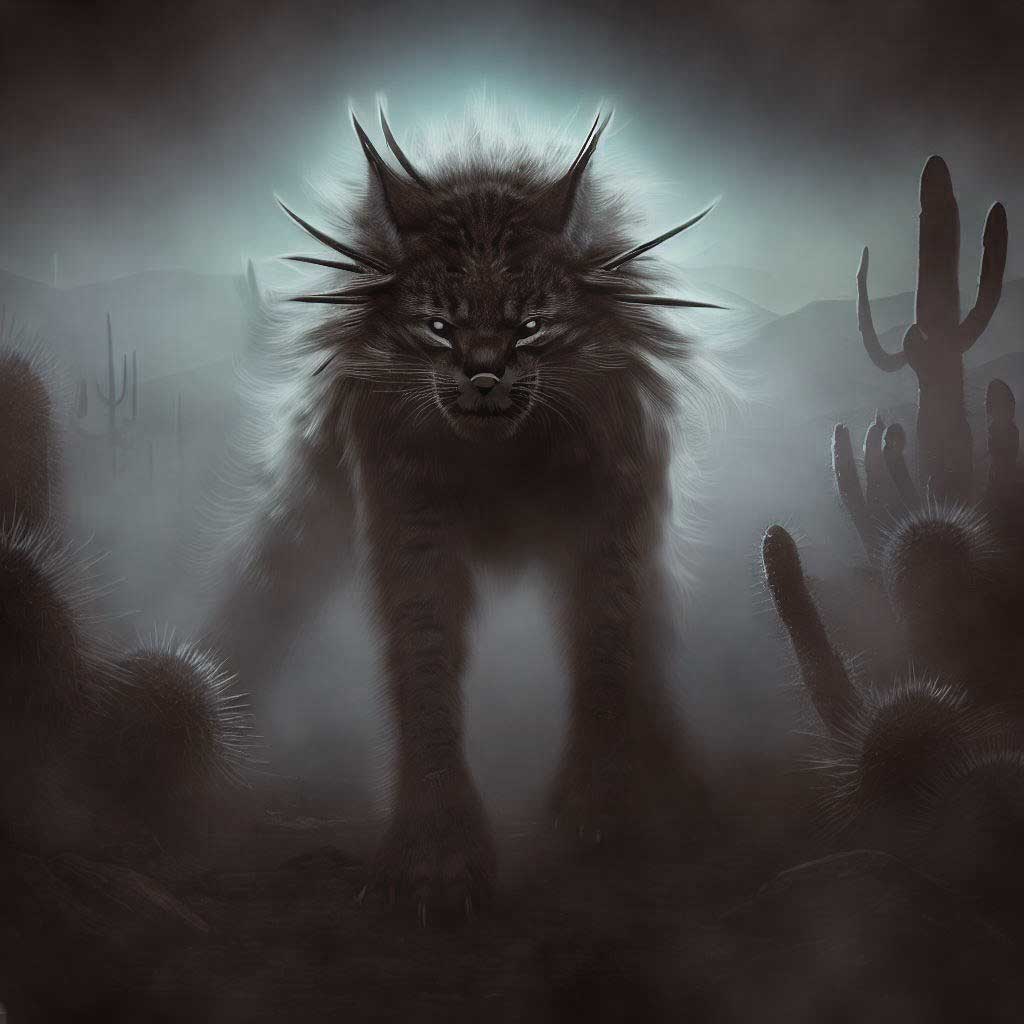The Cactus Cat is a feline cryptid that lives in the deserts of the American Southwest, particularly in areas where there are lots of cacti. It is said to love the cacti juice and some think that it might have a special preference for fermented cactus juice which leads it to becoming quite intoxicated!
| Cryptid Name: | Cactus Cat |
| Location: | Southwestern United States, particularly desert regions. |
| Category: | Feline Cryptid |
| Description: | Feline-like cryptid with fur that is sharp and spiny. |
| Size: | Typically described as a small to medium-sized animal about the size of a bobcat. |
| Behavior/Characteristics: | Nocturnal, agile, capable of leaping between cacti. Said to be hostile and territorial. |
| Diet: | Believed to feed on cactus juice, small mammals, and insects. |
| Habitat/Environment: | Arid desert environments with abundant cacti |
| Evidence: | No scientific evidence; considered a folklore creature |
| Sightings and Encounters: | Reported in local legends and stories, but no verified encounters. |
| Skepticism/Explanations: | Often attributed to misidentifications of other animals such as bobcat or mountain lion; folklore; myth. |
What Does The Cactus Cat Look Like?

The Cactus Cat is relatively small, about the size of a bobcat. It is said to be covered in hair that is more thorny than furry which is said to be long, sharp, and rigid especially on the ears and tail. It has sharp bones that protrude from its front legs and is also described as having a branched tale that is also covered in sharp spikes.
The Cactus Cat is nocturnal and will sleep throughout the day and hunt at night. It has a special liking for cacti juice which it extracts from cactus plants by using the sharp bones that protrude from its front legs. It is said to be aggressive and from all accounts, you wouldn’t want to cross its path!
The Cactus Cat Legend
The Cactus Cat legend has been around since the late 1800s with cowboys and explorers telling stories about this very strange and elusive cryptid. There are only a few recorded references to it that I could find. This reference is from a book called, “Fearsome Creatures of the Lumberwoods” which was published in 1910 – don’t you love its alleged scientific name (Cactifelinus inebrius)!
The Cactus Cat
Fearsome Creatures of the Lumberwoods – William Thomas Cox
(Cactifelinus inebrius)
How many people have heard of the cactus cat? Thousands of people spend their winters in the great Southwest – the land of desert and mountain, of fruitful valleys, of flat-topped mesas, of Pueblos, Navajos, and Apaches, of sunshine, and the ruins of ancient Cliff-dwellers. It is doubtful, however, if one in a hundred of these people ever heard of a cactus cat, to say nothing of seeing on sporting about among the cholla and palo verde. Only the old-timers know of the beast and its queer habits.
The cactus cat, as its name signifies, lives in the great cactus districts, and is particularly abundant between Prescott and Tucson. It has been reported, also, from the valley of the lower Yaqui, in Old Mexico, and the cholla-covered hills of Yucatan.
The cactus cat has thorny hair, the thorns being especially long and rigid on its ears. Its tail is branched, and upon the forearms above its front feet are sharp, knifelike blades of bone. With these blades it slashes the base of giant cactus trees, causing the sap to exude.
This is done systematically, with many trees being slashed in the course of several nights as the cat makes a big circuit. By the time it is back to the place of beginning the sap of the first cactus has fermented into a kind of mescal, sweet and very intoxicating. This is greedily lapped up by the thirsty beast, which soon becomes fiddling drunk, and goes waltzing off in the moonlight, rasping its bony forearms across each other and screaming with delight.
Is the Cactus Cat Real?
The Cactus Cat is a popular cryptid that is part of local legend and folklore but there is no scientific evidence to prove that it exists. Many have suggested that it could simply be a misidentification of other known animals such as bobcats or mountain lions. Some have also suggested that it could be a porcupine which would explain reports of spiky fur and quills.




